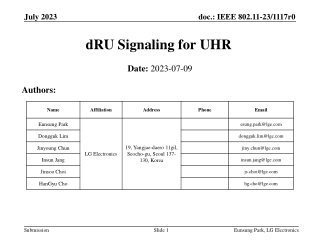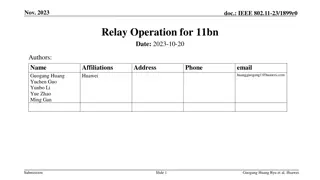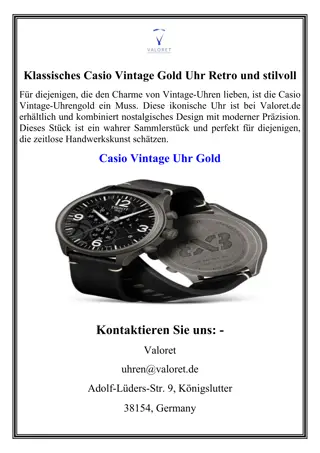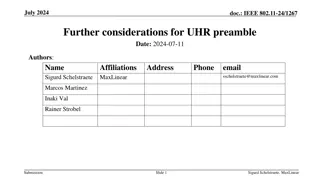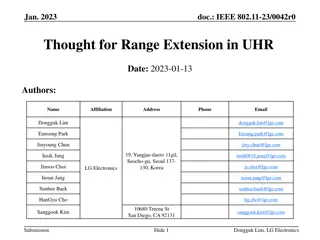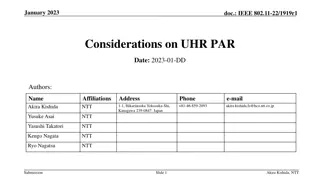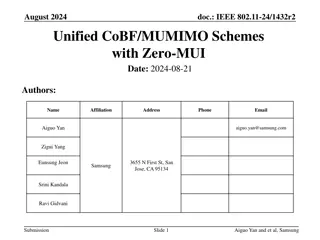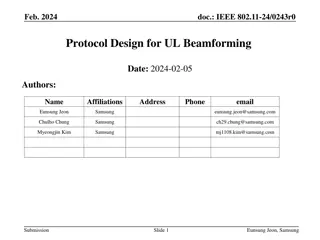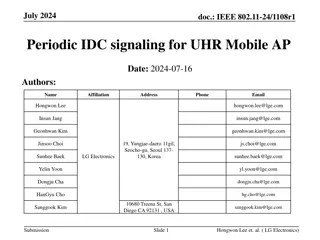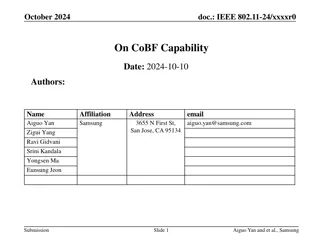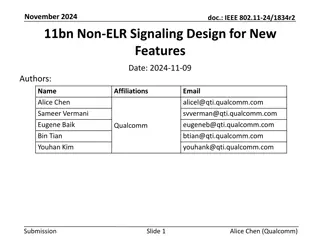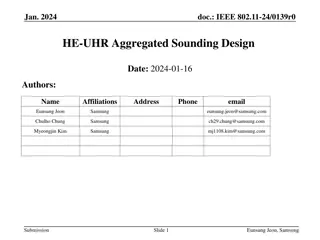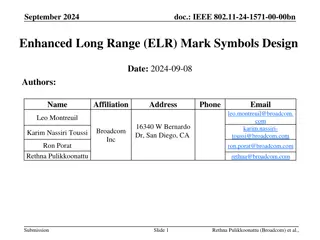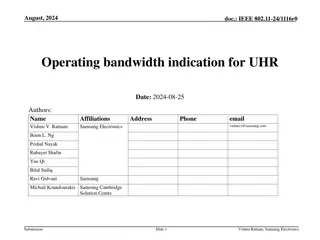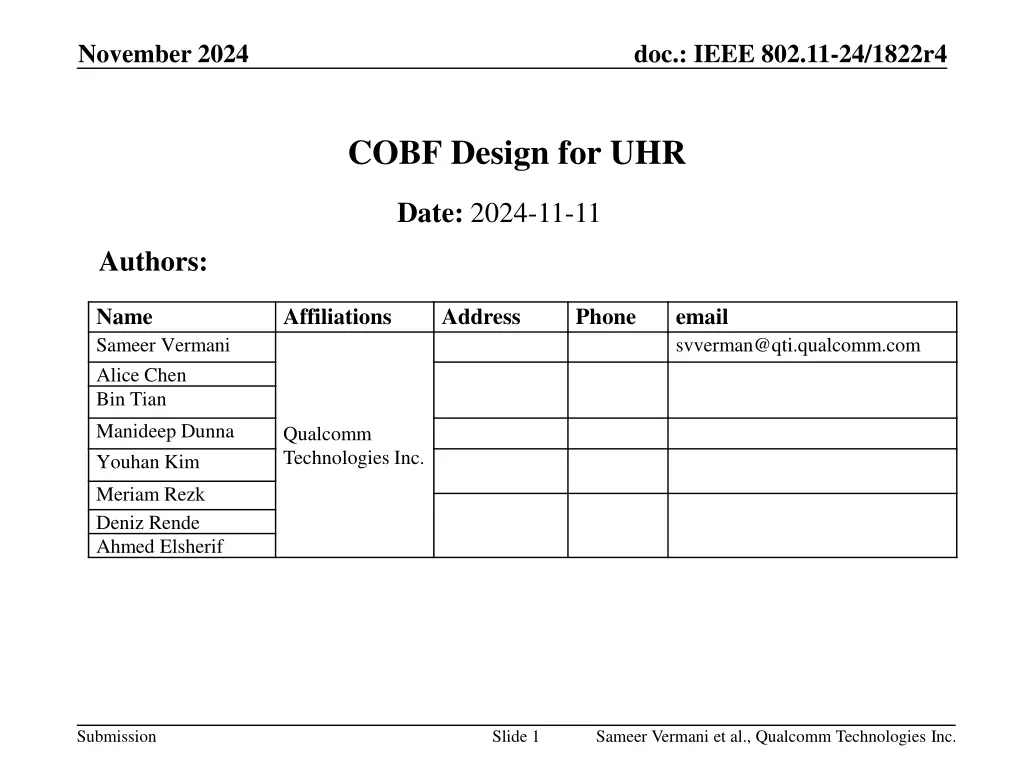
COBF Design for Ultra High Rate Wireless Networks in November 2024
Explore the innovative COBF design for ultra-high-rate wireless networks proposed by Sameer Vermani and team from Qualcomm Technologies Inc. The document outlines key aspects such as the number of users and spatial streams, PPDU design details, NDPA design, BSS color resolution, and more. Discover the efforts to limit the spatial streams and simplify signaling for optimum performance in COBF transmissions.
Download Presentation

Please find below an Image/Link to download the presentation.
The content on the website is provided AS IS for your information and personal use only. It may not be sold, licensed, or shared on other websites without obtaining consent from the author. If you encounter any issues during the download, it is possible that the publisher has removed the file from their server.
You are allowed to download the files provided on this website for personal or commercial use, subject to the condition that they are used lawfully. All files are the property of their respective owners.
The content on the website is provided AS IS for your information and personal use only. It may not be sold, licensed, or shared on other websites without obtaining consent from the author.
E N D
Presentation Transcript
November 2024 doc.: IEEE 802.11-24/1822r4 COBF Design for UHR Date: 2024-11-11 Authors: Name Sameer Vermani Alice Chen Bin Tian Manideep Dunna Youhan Kim Meriam Rezk Deniz Rende Ahmed Elsherif Affiliations Address Phone email svverman@qti.qualcomm.com Qualcomm Technologies Inc. Submission Slide 1 Sameer Vermani et al., Qualcomm Technologies Inc.
November 2024 doc.: IEEE 802.11-24/1822r4 Outline Number of users and spatial streams in COBF COBF PPDU design details Common pre-UHR portion preamble across two APs PPDU type indication: COBF as a separate PDDU type How to resolve BSS color for per-user SIG fields in COBF PPDUs BSS-wise partitioning of per-user SIG field section Design for NDPA NDPA variant remains same as EHT Using special STA info field; Unified design for Joint and Sequential Straw-polls related to above Submission Slide 2 Sameer Vermani et al., Qualcomm Technologies Inc.
November 2024 doc.: IEEE 802.11-24/1822r4 Number of users and spatial streams in COBF In 11-1542r0, we proposed restricting the number of APs to two in a COBF transmission We would further like to restrict the max number of STAs to 4 in a COBF transmission For the typical scenario, if we have more than 3 users belonging to an AP in a transmission, the AP is unlikely to have spare dimensions for nulling 4 total users provides opportunities for good amount of spatial multiplexing while keeping the processing at STA similar to regular MU- MIMO To further simplify the signaling and testing, we propose Limit max total spatial streams to 4 Limit the per-STA spatial streams to 2 Submission Slide 3 Sameer Vermani et al., Qualcomm Technologies Inc.
November 2024 doc.: IEEE 802.11-24/1822r4 Preamble Design: Common section of preamble across APs Propose having a non-BFed pre-UHR section of the preamble Simpler precoding U-SIG can be decoded at by-stander devices Closer to single cell MU-MIMO PPDU format BFed UHR portion Non-BFed Pre-UHR portion UHR- STF RL-SIG U-SIG UHR-SIG Data L-SIG L-STF L-LTF UHR-LTF Common contents across two APs Obvious consequence: Pre-UHR portion needs to be identical across two APs Need most things in the pre-UHR portion to be pre-negotiated Submission Slide 4 Sameer Vermani et al., Qualcomm Technologies Inc.
November 2024 doc.: IEEE 802.11-24/1822r4 Indication for COBF in U-SIG COBF transmission needs indication in U-SIG that the packet is for COBF Special treatment of BSS Colors Multiple BSS colors for the participant APs may be needed in COBF PPDU s preamble Per-user SIG field differentiation and for more accurate medium-use information The per-user SIG fields need to be differentiated Which AP are they coming from ? More on next slide Some preamble content may be simplified compared to regular UHR PPDU Maybe spatial reuse field is not needed for these PPDUs UHR-SIG MCS maybe fixed to a low MCS as we have longer delay spread to deal with Proposal: U-SIG to carry an indication when the PPDU is for COBF Submission Slide 5 Sameer Vermani et al., Qualcomm Technologies Inc.
November 2024 doc.: IEEE 802.11-24/1822r4 Per-user-SIG fields Issue: Need to resolve BSS label AP1 Nulls AP2 Same STAID (collision) BSS1 BSS2 How does the STA know which per-user SIG field to decode? Need to differentiate the per-user SIG fields in the common preamble Which BSS/AP do they belong to? Our proposal for differentiating the per-user SIGs of the two APs Place the two BSS colors in the preamble Have a 1-bit field in the per-user SIG field to differentiate between the two APs Submission Slide 6 Sameer Vermani et al., Qualcomm Technologies Inc.
November 2024 doc.: IEEE 802.11-24/1822r4 Per-user SIG Field Partitioning Prefer to separate the two BSSs per user-field sections E.g., All BSS-1 user fields and then all the BSS-2 user-fields or vice-versa An AP transmits on contiguous spatial stream indices With Nss_total <=4, it is possible, with some restrictions to the order of BSSs, to preserve the old spatial config field design See table below for more details Scenario Nss/User in AP1 [2] [2] [1] or [1 1] Nss/User in AP2 [2] [1] or [1 1] [2] Ordering of User Fields According to BSS The user field of either BSS can go first The user field of BSS1 goes first The user field of BSS2 goes first Each BSS has a user with 2ss Only one BSS has a user with 2ss No BSS has a user with 2ss [1] or [1 1] or [ 1 1 1 ] [1] or [1 1] or [1 1 1 ] The user field(s) of either BSS can go first Submission Slide 7 Sameer Vermani et al., Qualcomm Technologies Inc.
November 2024 doc.: IEEE 802.11-24/1822r4 New NDPA or NDP variants ? The NDPA in UHR can still use the EHT variant Special STA info field to convey information to a second AP for COBF case No need to define a UHR NDP Can reuse the EHT NDP, even for the joint NDP But the BSS color needs to be the BSS color of the AP transmitting the NDPA Submission Slide 8 Sameer Vermani et al., Qualcomm Technologies Inc.
November 2024 doc.: IEEE 802.11-24/1822r4 NDPA Design for UHR Exchange the information needed for sounding between APs for sounding via NDPA A special STA info field with a STAID addressed to the AP is needed Unified design for joint sounding as well as cross-BSS section of sequential sounding Prefer a self-contained design so may need two STA info fields to convey this information Special STA info field addressed to shared AP gives info about how to transmit the NDP, e.g., BW, TxOP and punctured channel information NLTF in NDP (P-matrix size) 4 or 8 Starting stream index for shared AP and Nsts for shared AP in NDP Which rows of P-matrix to use GI+LTF (at-least for joint NDP) Submission Slide 9 Sameer Vermani et al., Qualcomm Technologies Inc.
November 2024 doc.: IEEE 802.11-24/1822r4 Summary We proposed the following Maximum of 4 users in a COBF transmission Max total Nss of 4 for COBF with per-STA streams limited to 2 For COBF PPDU Identical preamble across 2 APs for the pre-UHR portion Two BSS colors with shared AP s color in the version independent section 1 bit in per-user SIG to resolve BSS color Per-user fields of one BSS and then per-user fields of the other BSS NDPA for COBF with a special STA info field Unified design for joint and sequential sounding cases Submission Slide 10 Sameer Vermani et al., Qualcomm Technologies Inc.
November 2024 doc.: IEEE 802.11-24/1822r4 SP1 Do you support to add the following to the SFD: The pre-UHR portion (the portion up-to UHR-SIG) of the COBF PPDU shall be transmitted in a non-beamformed (omni) manner? Submission Slide 11 Sameer Vermani et al., Qualcomm Technologies Inc.
November 2024 doc.: IEEE 802.11-24/1822r4 SP2 Do you support to add the following to the SFD: The pre-UHR portion of a COBF PPDU shall have identical content across two APs. Submission Slide 12 Sameer Vermani et al., Qualcomm Technologies Inc.
November 2024 doc.: IEEE 802.11-24/1822r4 SP3 Do you support to add the following to the SFD: COBF data transmission shall be indicated in the U-SIG for 802.11bn Submission Slide 13 Sameer Vermani et al., Qualcomm Technologies Inc.
November 2024 doc.: IEEE 802.11-24/1822r4 SP4 Do you support to add the following to the SFD: In a COBF transmission, the maximum spatial streams given to one user will be 2 Submission Slide 14 Sameer Vermani et al., Qualcomm Technologies Inc.
November 2024 doc.: IEEE 802.11-24/1822r4 SP5 Do you support to have 2 BSS colors in the preamble of a COBF PPDU One BSS color for the sharing AP and another BSS color for the shared AP Submission Slide 15 Sameer Vermani et al., Qualcomm Technologies Inc.
November 2024 doc.: IEEE 802.11-24/1822r4 SP6 Do you support to have a 1-bit indication in the per-user SIG field to resolve the BSS color for COBF transmissions? The coding bit is re-purposed for this indication LDPC is the only coding mode for COBF Submission Slide 16 Sameer Vermani et al., Qualcomm Technologies Inc.
November 2024 doc.: IEEE 802.11-24/1822r4 SP7 Do you agree to add the following to the 11bn SFD? The spec shall re-use EHT variant for the NDPA and re-use the EHT NDP for sounding in UHR Submission Slide 17 Sameer Vermani et al., Qualcomm Technologies Inc.
November 2024 doc.: IEEE 802.11-24/1822r4 SP8 Do you agree to add the following to the 11bn SFD? For the COBF case, the information in the NDPA for the responding AP has a unified design for joint-NDP based sounding as well as cross-BSS section of sequential sounding. Submission Slide 18 Sameer Vermani et al., Qualcomm Technologies Inc.
November 2024 doc.: IEEE 802.11-24/1822r4 SP9 Do you agree to add the following to the 11bn SFD? The spatial config field in the user-SIG field of COBF PPDUs in UHR will re-use the same design as in UHR DL MU-MIMO. Encoding table will be same as 11ax Submission Slide 19 Sameer Vermani et al., Qualcomm Technologies Inc.
November 2024 doc.: IEEE 802.11-24/1822r4 SP10 Do you agree to add the following to the 11bn SFD? For a COBF PPDU, all the user-fields in UHR-SIG belonging to an AP and the corresponding spatial streams are contiguous. The user fields of one AP are together followed by the ones of the other AP and the same holds for spatial streams Submission Slide 20 Sameer Vermani et al., Qualcomm Technologies Inc.
November 2024 doc.: IEEE 802.11-24/1822r4 SP11 Do you agree to add the following to the 11bn SFD? There is no UHR sounding sequence for SU TxBF or DL MU-MIMO. UHR SU TxBF and UHR DL MU-MIMO uses EHT sounding sequence. Submission Slide 21 Sameer Vermani et al., Qualcomm Technologies Inc.
November 2024 doc.: IEEE 802.11-24/1822r4 Other details APPENDIX Submission Slide 22 Sameer Vermani et al., Qualcomm Technologies Inc.
November 2024 doc.: IEEE 802.11-24/1822r4 Protection for COBF transmissions Note that there are going to be some frames exchanged between the two APs before the COBF transmission A frame from initiating AP (e.g., a COBF trigger) may be used to set the NAV in BSS1 We may also place the responding AP s BSS color in the version independent section of the U-SIG for protection inside BSS2 Note that even WiFi 7 devices understand the BSS color in U-SIG at that location Additionally, suggest having a rule in the specification for the case when the STA can decode U-SIG with a version number it doesn t understand Disable OBSS_PD based SR for such cases Note that SR field is not in the version independent section so whenever a WiFi 7 STA sees a UHR PPDU, it will not have access to the SR field Submission Slide 23 Sameer Vermani et al., Qualcomm Technologies Inc.
November 2024 doc.: IEEE 802.11-24/1822r4 Explanation of protection mechanism for COBF Below we show protection mechanisms to achieve good protection in both BSSs Contains BSS color of shared AP in U-SIG version independent section Protects in sharing AP s BSS COBF trigger COBF Invite Sharing AP DL PPDU Shared AP COBF DL PPDU Response Submission Slide 24 Sameer Vermani et al., Qualcomm Technologies Inc.

